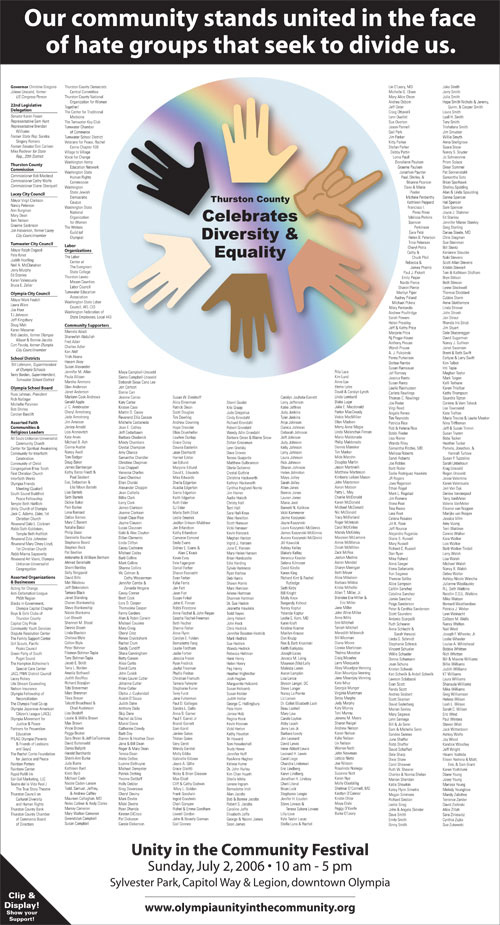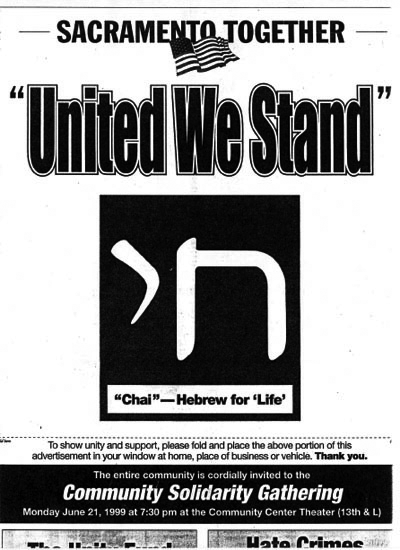News Organizations Have Served as Powerful Allies in NIOT Campaigns Across the Country
 In 2006, when the neo-Nazi group the National Socialist Movement (NSM) decided to organize in Olympia, Washington, the grassroots coalition Unity in the Community turned to the local newspaper The Olympian. After a series of meetings with the newspaper’s editorial board, The Olympian reported on Unity's work to counter the NSM’s hateful message and donated the advertising space to publish an ad for the group. A number of organizations, government agencies, and individuals signed onto the full-page advertisement under the banner “we stand united in the face of hate groups that seek to divide us.”
In 2006, when the neo-Nazi group the National Socialist Movement (NSM) decided to organize in Olympia, Washington, the grassroots coalition Unity in the Community turned to the local newspaper The Olympian. After a series of meetings with the newspaper’s editorial board, The Olympian reported on Unity's work to counter the NSM’s hateful message and donated the advertising space to publish an ad for the group. A number of organizations, government agencies, and individuals signed onto the full-page advertisement under the banner “we stand united in the face of hate groups that seek to divide us.”
“We’re going to cover the Nazis when they come here as we would any other news story,” said John Wynn, the publisher of The Olympian. “At the same time, on the editorial page and in my role as publisher, we can take sides and be strong advocates for the values of the community. We’re going to take a very activist role against [the NSM’s] message because we find it reprehensible.”
- In 2005, current and former members of the Fort Collins Human Rights Commission decided to organize a Not In Our Town Alliance to increase awareness of discrimination and bias and encourage action when hateful incidents occurred in the Colorado community. To help Ft. Collins embrace the ideals of the NIOT Alliance, the local newspaper The Coloradoan printed a front-page story about the alliance’s first forum, and in a published editor’s note from executive editor Michael Limon, the paper committed to “continue to create awareness about hate-motivated behavior and editorially advocate for those who are oppressed.”
- After a small group of Klansmen announced in 1996 that they would march in Kokomo, Indiana, The Kokomo Tribune decided to print in the newspaper “A Message of Tolerance” petition and pledge card. “The community really got around it,” said Joe Follick, the paper’s Op-Ed editor. “We had kids that went around to the playgrounds and passed the petitions around. Kids signed them and brought them in. Churches and civic organization [also got involved.] I would come into work and there’d be another 150 [pledge cards] sitting on my desk.”
The Kokomo Tribune also printed a poster that read “Stop Hate,” which could be seen in windows all around town before the Klan even showed up. The day of the KKK action, community members opposed to their message gathered across town at a counter event dedicated to unity and celebrating the diversity of Kokomo.
 After three Sacramento, CA, synagogues, were firebombed early one summer morning in 1999, almost as quickly as the fires were started, the community of Sacramento mobilized to take a stand against anti-Semitic hate crimes. Within days after the attacks, dozens of public officials and community leaders attended a community rally to send a message of unity and strength and donate thousands of dollars to help rebuild the synagogues. Organizers handed out a poster with the slogan "Sacramento Together United We Stand" and “Chai,” the Hebrew character for life. The local newspaper The Sacramento Bee decided to publish the poster as an insert and encouraged readers to display it in their windows.
After three Sacramento, CA, synagogues, were firebombed early one summer morning in 1999, almost as quickly as the fires were started, the community of Sacramento mobilized to take a stand against anti-Semitic hate crimes. Within days after the attacks, dozens of public officials and community leaders attended a community rally to send a message of unity and strength and donate thousands of dollars to help rebuild the synagogues. Organizers handed out a poster with the slogan "Sacramento Together United We Stand" and “Chai,” the Hebrew character for life. The local newspaper The Sacramento Bee decided to publish the poster as an insert and encouraged readers to display it in their windows.
“Here’s an old fashioned medium, a print newspaper, that can disseminate in one morning a message that can not only be read, but can be placed in people’s store fronts and automobiles and homes in a way that can really make you feel the power of people acting and taking a sort of affirmative step,” said Steven Weiss, vice president of marketing & public affairs for The Sacramento Bee.
The next night, 5,000 people participated in a Community Solidarity Gathering, where more than 300 clerics of diverse religious backgrounds, civic leaders, and law enforcement officials shared the stage to demonstrate their unity.
Add new comment